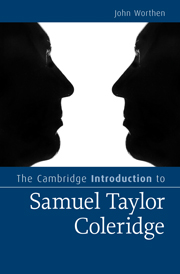Book contents
- Frontmatter
- Contents
- Illustrations
- Preface
- Acknowledgements
- Abbreviations
- Chapter 1 Early life and contexts: 1772–1802
- Chapter 2 Poetry
- Chapter 3 Notebooks
- Chapter 4 Mid-life works and contexts: 1803–1814
- Chapter 5 Language
- Chapter 6 Criticism
- Chapter 7 Later works and contexts: 1815–1834
- Afterword
- Notes
- Further reading
- Index
- Cambridge Introductions to Literature
Chapter 4 - Mid-life works and contexts: 1803–1814
Published online by Cambridge University Press: 05 August 2012
- Frontmatter
- Contents
- Illustrations
- Preface
- Acknowledgements
- Abbreviations
- Chapter 1 Early life and contexts: 1772–1802
- Chapter 2 Poetry
- Chapter 3 Notebooks
- Chapter 4 Mid-life works and contexts: 1803–1814
- Chapter 5 Language
- Chapter 6 Criticism
- Chapter 7 Later works and contexts: 1815–1834
- Afterword
- Notes
- Further reading
- Index
- Cambridge Introductions to Literature
Summary
The years which might have been Coleridge's major creative period, from the age of thirty-one to forty-two, were seriously damaged by his opium habit. He wrote in 1805 about his ‘sense of self-degradation’ on consuming ‘the long wretched Dose’ (CNii. 2602); he brought his marriage to an end in 1806 but continued to suffer difficulties in settling to any project, crushing guilt over his failure as man, father and writer, and an awful sense of inadequacy. He suffered terrible bouts of pain; at times he thought he was dying.
These problems were succeeded around 1810 by his alienation from the closest of his early friends. He kept thinking, he kept reading (we find him planning to buy some £28 worth of scholarly books in 1808); he continued to write the occasional short poem between 1803 and 1815; on occasion he produced political journalism for the Courier, as in 1809–10 and 1811. But (with the exception of the enterprise of The Friend between 1809 and 1810) his intellectual and creative energies went into letter-writing, notebook-keeping, lecturing and planning books he could not write. At times, in desperation, he announced their readiness for the press, or even their being printed, when they were not even begun (e.g. CLiii. 133; Friendii. 36–7). These years of ‘despondent objectless Manhood’ (CNiii. 4048) were not only a terrible period but – apart from The Friend – in many ways a creative wasteland too.
- Type
- Chapter
- Information
- The Cambridge Introduction to Samuel Taylor Coleridge , pp. 62 - 72Publisher: Cambridge University PressPrint publication year: 2010

